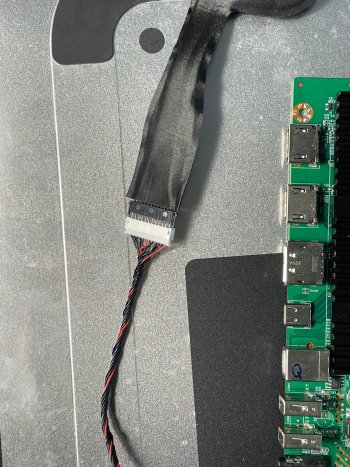So I got it hooked up to my panel last night (from a 2014 5K iMac), and have some mixed but encouraging results...
I'll add them in-line with prior posts about the T18:
- 5k60 works via single cable, USB-C to USB-C or USB-C to Displayport from M1 Macbook Air, (HDMI not tested yet)
- "billions of color" so I figure it supports 10bit
I can second this. I didn't try USB-C to USB-C yet (for reasons indicated below), but USB-C to DP worked great and detected the full resolution immediately. Just as with your test, the 4:4:4 chroma sample looks perfect. 👍
For HDMI from the M1, if that is possible, I think it might take a third-party HDMI adapter? My understanding is that the Apple dongle (at least the one with the USB-C, HDMI, and USB-A ports) doesn't support resolutions that high...
I tried it while I had mine connected (HDMI via that dongle from a M1 MBA), and couldn't get full resolution even at 30Hz refresh rate - it wouldn't show it as an option.
Unfortunately, no luck on getting any more detailed output form the OSD.
View attachment 2187488
The OSD surprised me. This is the first monitor I've ever had that won't let you interact with the OSD unless a video signal is present on one of the ports. Without an active video signal, the monitor briefly says "No Cable", then "Power Saving", and immediately goes blank, even if you are pressing buttons on the control panel. And that little info window you posted is only shown when the monitor first syncs to the signal - there is basically nothing else available in the menus.
It's not all bad though - it does seem to be very quick to select and activate the input - something I can't say about my other monitors.
Note that the board came with no instructions on how to connect or wire things up, whatsoever.
I guessed the 'correct' orientation for the LCD power from the (sellers) jpeg below.
Thanks for that. I used your screen capture initially, then later (before I had powered it up), I also found another image in another seller's T18 listing, which shows the orientation more clearly:

Curiously though, I found this image in a listing for the R1811, which shows a cable with the same non-symmetrical sequence of red and black wires, but plugged in 180-degrees rotated? 🤷♂️

After two weeks of testing, and given that I cannot compare to other boards myself, I think the T18 is a decent solution. Some more notes:
- I had occasional dropouts. When my automated plant light turns on (same wall-outlet), it might trigger a reset and the board restarts. But this also happens with other screens — I should probably avoid these minisurges 😅.
- A bit more worriesome was one random shutdown after a few hours of use. Only a full power-cycle helped, disconnecting the power supply from the wall-outlet. I briefly checked the temps of the board and psu, both were warm to touch but not worse than a macbook under load. I think this might be due to the powerbrick. I will keep monitoring and might replace it for a spare magsafe, but since it only happened once its a low prio.
I unfortunately can report the same. I made it about 40 minutes or so, and the display "blinked".

I unplugged it and started checking my setup, since I was only bench testing without anything mounted. The display itself was warm, and the T18 PCB was generally warm across... but the power adapter was HOT! And when I say "hot", what I mean is that it was way too hot to hold onto - reflexes pull your hand away.

The T18 PCB, in contrast, was not too hot to touch anywhere on the PCB or heatsink.
Sooo... I think it must draw more power than expected... either that, or the no-name power adapter is a poor design or isn't living up to its ratings. Once I have time, I think I'll measure the power draw at the wall - that will tell me if the system as a whole is within what the power supply should be rated at, and will give me a clue where the issue may be. Replacing the power supply wouldn't be a problem, but I would have to figure out the dimensions for the connector.
Also, if the power supply while sitting on a bench isn't up to the task of powering the monitor alone, I'm 100% certain it wouldn't be happy inside a monitor... nor would it be up to the task of charging a connected device via USB type C PD. 😬
The T18 firmware seems to have made a mess of button mapping. On the PCB, buttons are labeled “Menu Down Up Enter Power”, but the actual functions are “Power Back + − Enter”. (The +/− buttons moves menu selection down/up respectively, but, when used to adjust brightness etc, they increment/decrement the value, which is shown as the bar going up/down.)
I'm so glad you guys both posted about the button mappings being off. My unit arrived with the OSD language set to Chinese, and attempting to navigate the menus was a bit of an issue until I got my head wrapped around the control layout! 🤣




